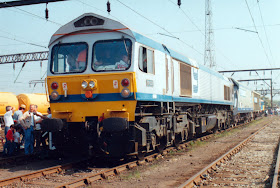Up until the Class 59 nearly all diesel locomotives and units operated on British metals had been British made but this changed after the Class 59 was introduced. Though the numbers of this locomotive built where in the end pretty small it directly led to the Class 66 (which is very similar externally though different internally) which was built in huge numbers (eventually 455) now handles the majority of freight traffic on the network.
| Information | |
|---|---|
| Number built: | 15 |
| Built: | 1985-95 |
| Builder: | GM-EMD USA (59/0) and GM-DD Canada (59/1 and 59/2) |
| Engine: | EMD 16-645E3C |
| Power: | 3, 300 hp (2, 460 kW) |
| Wheel arrangement: | Co-Co |
Following Foster Yeoman's fleet of 5 (59/0) the type was also ordered by ARC Southern (59/1) who bought 4 and National Power (59/2) who bought 6. There are differences between the 3 sub-classes with the latter 2 sub-classes able to travel at higher speed than the original Foster Yeoman locomotives. The 59/2s also have more advanced slow-speed control for coal merry-go-round trains.
All are now operated by Mendip Rail on behalf of Foster Yeoman and ARC who retain overall ownership, except 59 003 which spent some time in Germany before being bought by GB Railfreight and returned to the UK.
 |
| GB Railfreight operated 59 003 |
 |
| 59 005 in original Foster Yeoman livery at Bescot open day in 1988, photographer unknown (KD collection) |
[1] Colin J. Marsden, Traction Recognition (2nd Edition) (Ian Allan, 2009) p. 61







